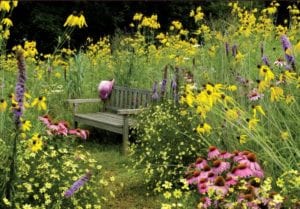A Truly Green Lawn
 We Americans certainly love our lawns. The small yards of urban dwellings have grown into relatively common quarter-acre lots, and larger homes often rest on sprawling plots of land that are 2-4 times that size. Corporate properties sport lush lawns and landscapes that offer a country club quality. In total, we have over 40 million acres of lawn, and spend $30 billion each year maintaining those lawns.
We Americans certainly love our lawns. The small yards of urban dwellings have grown into relatively common quarter-acre lots, and larger homes often rest on sprawling plots of land that are 2-4 times that size. Corporate properties sport lush lawns and landscapes that offer a country club quality. In total, we have over 40 million acres of lawn, and spend $30 billion each year maintaining those lawns.
Lawns are an important part of our communities. They absorb rainwater, which reduces storm water runoff, and filter contaminants as groundwater supplies are replenished. Lawns also have a cooling effect, and convert CO2 to oxygen. They trap dust and dirt, prevent erosion, and promote a healthy ecosystem of valuable micro-organisms.
We take great pride in presenting a beautiful green lawn, and spend a great deal of time and/or money to make that happen. This includes fertilizers to make the grass grow, insecticides to eliminate pests that might damage the lawn, and herbicides to eliminate unwanted weeds. Unfortunately, much of these chemicals leach into our waterways, with adverse effects on natural ecosystems. While the Midwest, with Missouri in particular, is blessed with a relative abundance of water, other geographic areas use a disproportionate amount of their water (60% on the west coast) to green their lawns.
It’s okay to take pride in your landscape. Just consider taking some steps to do it in a more sustainable way. Here are a number of tips to green your lawn in a green way.
- Choose native grasses. If you’re starting from scratch, be sure to choose a locally-adapted grass. Just because you grew up with Kentucky Bluegrass doesn’t mean that’s what’s best for your yard. Buffalo grass and other low/no mow varieties can be used to reduce or eliminate watering and mowing.
- Build a xeriscape or rain garden. Xeriscapes use rocks and native plants that eliminate the need for watering, and rain gardens pool stormwater so that it can soak into the ground.
- Raise you mower height. Giving your lawn a military cut exposes surface roots and dries out the soil. Don’t cut more than a third of the grass at a time.
- Don’t bag it, mulch it. Yard waste makes up almost 20% of our municipal waste. Mulching blades cut up the grass into tiny pieces, which provides healthy organic matter back into the soil.
- Aerate & dethatch. Power-raking the lawn removes thatch that prevents water and nutrients from reaching the grass roots. Aerating removes finger-sized plugs of soil to reduce soil compaction, which allows roots to grow deeper.
- Water infrequently and deeply. If your lawn requires water, it’s best to saturate the lawn in the morning no more than once a week. Watering in the morning reduces evaporation; put a cup in the sprinkler area to capture an inch or so of water for a healthy lawn.
- Use organic fertilizers. Your lawn can benefit from additional fertilizer once or twice a year, but avoid synthetic fertilizers and be careful to not turn your grass into an addict.
- Add ground cover. You can designate certain areas of your lawn for ground cover – particularly those areas that don’t have much traffic. These can be low-lying ivies, succulent sedums, periwinkle, ajuga, or any of a wide variety of plants, depending on the soil and shading. You can also plant a bed of sun-loving wildflowers in the middle of your lawn.
- Minimize pesticides and herbicides. These are poison, and should be used sparingly if at all. There are natural products like vinegar and corn gluten to control weeds, and other organics like milky spore to eliminate grubs. Consider plucking dandelions by hand early with Weed Hound (hound-dog.com).
- Consider electric mowers or reel mowers. Mowers emit 10-12 times as much CO2 as a car per hour of operation. Electric mowers are clean and quiet, and reel mowers are much lighter and easier to operate than your grandfather’s! It’s also good exercise.
It’s time to rethink what a “green” lawn really is. See what kind of low-lying fruit you can pick from above, and start down the path to creating a healthier and more sustainable landscape in your own yard.
This will be published in the Going Green section of the May 2012 issue of Spirit Seeker magazine.
